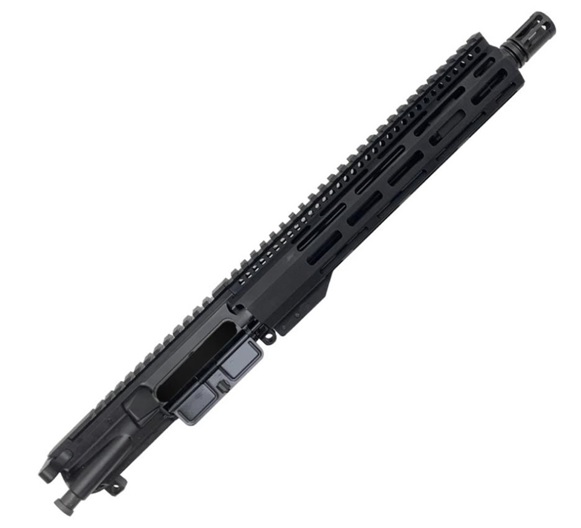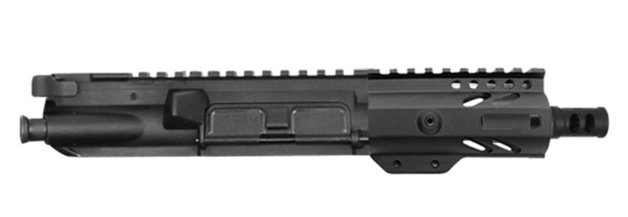Unlike break-action, single-shot rifles, AR-15 platforms and other sporting rifles are much more complex and have many more specialized parts.
If you own one or are thinking about building one, these are the parts you should become familiar with.
● AR15 upper receiver (and parts)
The AR15 upper receiver is one-half of the platform’s receiver, the other being the lower. The upper receiver is either machined (billet) or forged (AKA mil-spec) from a piece of aluminum and joins the barrel to the lower receiver.
The AR15 upper receiver also contains the following parts:

- Bolt carrier group: The bolt carrier group is the body that makes up most of the bolt carrier. It often has a black phosphate finish but can be nitrided, hard chrome, or one of many other BCG finishes. The bolt carrier group also contains:
- Bolt: Blocks the rear of the chamber and locks it shut.
- Firing pin: This part actually strikes and ignites the primer.
- Firing pin retainer pin: Holds the firing pin in place in the BCG, allowing it a certain range of freedom of back-and-forth movement.
- Bolt carrier key and screws: The key fits over the gas tube and is an essential gas system component that allows the BCG to move rearward when the rifle is fired.
- Bolt gas rings: These are elastic seals between the bolt body and the walls of the bolt carrier, ensuring a snug fit.
- Cam pin: Locks the bolt in the barrel extension, ensuring a proper fit between the bolt and barrel.
- Extractor, pin, spring, and insert: The extractor is a hook-like part that grabs the rim of the casing in the chamber, allowing it to be removed when the bolt moves rearward out of battery, opening the action.
- Ejector, roll pin, and spring: The ejector is the part that ejects the spent casing clear of the action when the BCG moves rearward after firing.
- Charging handle: The charging handle is a part that is used to manually cycle the action and to clear jams in the case of a malfunction. The assembly contains also a a latch, latch roll pin, and spring.
- Carry handle (if present): This is a (usually aluminum) component mounted to the upper receiver (or rail) and used to carry the rifle.
- Forward assist: A component used to manually close the action if it fails to return to battery. It also contains a plunger and spring pin.
- Ejection port cover, spring, and pin: The ejection port cover allows the ejection port to be covered except when the action is opened, keeping dust, dirt, and other contaminants out of the action.
- Gas tube: Connected to the barrel and usually mounted under the handguard, the gas tube captures gas and uses it to cycle the bolt carrier group. The gas tube also contains a roll pin which secures it.
- Barrel, extension, and indexing pin: The barrel contains an extension which recesses into the upper receiver and ensures a proper fit between both. The indexing pin ensures that the barrel remains in the proper orientation during use. If the barrel is threaded and has a muzzle device mounted there will also be a crush washer.
- Barrel nut: This nut secures the barrel in place to the upper receiver and requires very specific torquing.
- Handguard: The hanguard is a hollow component, usually but not always with rails, that mounts around the barrel. Most handguards have either Picatinny, M-LOK, or KeyMod rail slots that allow the mounting of accessories. It also functions as a barrel shroud that can be used as a grip.
- Front sight post, detent, and spring
- Rear sights: The rear sight, which is adjustable for windage and elevation, will contain a base, ball bearing, helical spring, and windage and elevation knobs, as well as an aperture and flat spring.
● AR15 lower receiver (and parts):
The AR15 lower receiver, like the upper, is a part either milled (billet) or forged from aluminum. This is the part that is serialized by the ATF and considered a firearm. It houses the trigger group, accepts the magazine, and serves as the attachment point for the buffer system, stock, and pistol grip.

- Takedown pins, spring, and detent: There are two takedown pins (pivot pin and rear takedown pin) that secure the AR15’s upper and lower receivers. They are held in place by springs and detents.
- Buffer tube and receiver extension: The buffer tube will also contain a set of weights and a buffer spring. These are used to increase the reciprocating mass of the rifle and store potential energy to reset the action. The receiver extension also has a nut that secures it in place. A buffer retainer and spring hold secure the buffer tube.
- Telescoping stock: The buffer tube system serves as an attachment point for the stock.
- Pistol grip: This part is secured to the bottom of the lower receiver behind the magazine chute by a pistol grip screw and lock washer.
- Hammer and trigger pins: These secure the hammer and trigger in place and prevent them from walking out.
- Hammer and spring: The hammer strikes the firing pin when the trigger releases the sear; the spring stores the energy necessary to do so.
- Trigger guard and pivot roll pin: The trigger guard helps prevent accidental contact with the trigger and is secured with a roll pin.
- Trigger, trigger spring, disconnector, and spring: The trigger spring applies tension to the trigger and the disconnector disengages the connection between the trigger and sear and ensures proper semi-automatic functionality.
- Fire selector lever, detent, and spring: The fire selector enables the shooter to select a mode of fire and is held in place by a detent and spring.
- Bolt catch, roll pin, plunger, and spring: The bolt catch holds the bolt back once it has cycled to the rear. The plunger, spring, and roll pin secure the system.
- Mag catch spring and button: The mag catch secures the inserted mag in the chute and the button releases it.
● Magazine (and parts)
Though not technically a part of the AR platform itself, the magazine consists of a mag body, a mag spring, a floor plate, and a follower.
AR15 Uppers, Lowers, Parts and Build Kits
Ready to get started on your home build with high-quality parts? In addition to complete upper receivers, we also sell lower parts kits and build kits, as well as miscellaneous parts, magazines, handguards, charging handles, muzzle devices, and much more.
Check them out in our collection and get in touch with us at Sales@MCSGearup.com if you need assistance.

